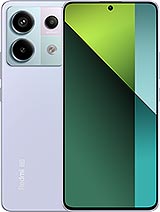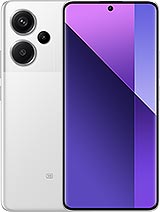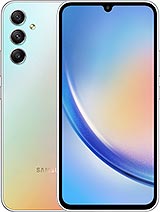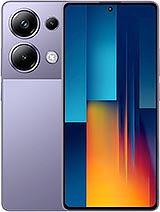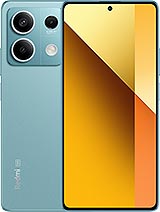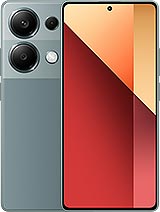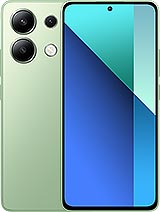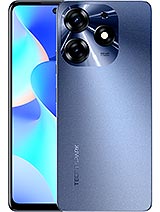Xiaomi Redmi Note 13 4G review

MIUI 14 on top of Android 13
The Redmi Note 13 4G runs MIUI 14 on top of Android 13. All Redmi Note 13 models will get an update to HyperOS later on.
Xiaomi hasn't committed officially to a specific number of future updates. Still, it will likely be the same as on the Poco X6 models - three years of major Android updates and an extra year with security patches only.

MIUI 14 has changed little over the 13th iteration in terms of overall user experience, and that's not bad. It's just as snappy and customizable as ever. Xiaomi has paid special attention to the haptics of this unit as well - we found the motor to be crisp, strong, accurate, and responsive. It reacts to many actions across the system and when navigating. There's even a haptic feedback intensity if you find it obtrusive or not strong enough.
Some ads can be stopped from within the Settings in the app that shows advertisements and/or recommendations.
We already did an extensive walkthrough of MIUI 14 on top of Android 13. You should check that out for a better overview of the UI and features.
Performance and benchmarks
The Redmi Note 13 4G is a midranger, not a particularly powerful one. It is based on the Snapdragon 685 chipset. That is a pretty modern part, dating back to the beginning of 2023 and made on a 6nm TSMC manufacturing node.
The CPU department has a total of eight cores to work with - four Cortex-A73 ones clocked at up to 2.8 GHz and another four Cortex-A53 cores working at up to 1.9 GHz.

The GPU is a 1260 MHz Adreno 610. Dual-channel 2133 MHz LPDDR4X RAM backs up the Snapdragon 685.
The Redmi Note 13 4G comes with either 6GB or 8GB of it. There are UFS 2.2 chips for storage with a total capacity of 128 GB or 256 GB. Storage is expandable via a microSD card.
Our particular review unit is equipped with 8GB of RAM and 256GB of storage, making it the top-tier model.
Let's kick things off with some CPU runs and GeekBench. Unfortunately, the Redmi Note 13 4G is closer to the bottom of the performance chart than its price peers. It still holds its own fairly well but is relatively lagging behind the performance of the Dimensity 6080 inside the Redmi Note 13 5G, as well as other popular chips in the price range like the Helio G99.
You could get a lot more performance for your money with a chip like the Dimensity 8020, 8050 or the Snapdragon 7s Gen 2. The Dimensity 7030 and 1080 also rank a bit higher in terms of CPU performance.
AnTuTu is a much more compound benchmark that includes GPU and memory tests. It places the Redmi Note 13 4G and its Snapdragon 685 chip about where we would expect in the chart.
At least the Redmi Note 13 4G has devices like the Moto G84 with its Snapdragon 695 and the Samsung Galaxy A15 with its Helio G99 beat, even if slightly, in AnTuTu testing.
The Adreno 610 GPU inside the Snapdragon 685 is a real letdown. It basically sits at the very bottom of the graphics performance charts.
We've discontinued GFXBench graphics benchmarking as the app is often banned/blacklisted on the phones we receive for review. The graphics performance ranking in 3D Mark is just as meaningful, so we suggest you refer to that one instead.
The Adreno 610 struggles to power even lighter games properly.
Unfortunately, the Snapdragon 685 left us wanting in the performance department. Even in purely practical terms, with things like running the phone's UI smoothly, the chip leaves a lot to be desired. The Redmi Note 13 4G doesn't feel smooth or snappy but rather slow and sluggish. There are no actual stutters in animations and transitions, which is at least good to see, but performance is still very much subpar.
Thermal-throttling
The Snapdragon 685 might not be particularly powerful, but at least it does not produce excessive heat. The Redmi Note 13 4G handles prolonged stress testing easily and gracefully. The phone holds sustained performance very well over time.
Not only that, but the surface of the Redmi Note 13 4G doesn't really heat up. It gets lukewarm, but that's about it. It always remains perfectly comfortable to hold.
Connectivity
Unlike its 5G sibling, the Redmi Note 13 4G lacks 5G connectivity and is limited to 4G/LTE. It offers that simultaneously on both of its nano SIM card slots. Thanks to its X11 LTE modem, it can do theoretical maximum 4G download speeds of up to Cat 13 or 390 Mbps down and 150 Mbps up.
Unfortunately, the SIM tray on the phone is a hybrid affair. You have to choose between a second SIM card or a microSD card for expandable storage. There appears to be no e-SIM support.

The Redmi Note 13 has dual-band Wi-Fi ac and Bluetooth 5.1 with LE support for local connectivity. There is also NFC on board, as well as an IR blaster.
There is no FM radio. For positioning, we find a GPS/GLONASS receiver. The Type-C port relies on a USB 2.0 connection, which means a theoretical maximum data transfer rate of 480 Mbps. There is USB OTG/Host support, but nothing more beyond that, like video output via USB Alt mode.

The Redmi Note 13 4G has a pretty good set of onboard sensors. These include a BOSCH bmi3x0 accelerometer, gyroscope combo, and AMS tmd2755 light and proximity sensor. The proximity sensor is, thankfully, a hardware one and works as expected, even though it is a bit slow to react. There is also a QST qmc630x magnetometer. No barometer is present, though.
Reader comments
- Idiokitaha
- 23 Apr 2025
- XBF
I'll be getting this phone soon. I was using the Xiaomi mi 10t lite, until it started misbehaving. I needed this one because of the pip mode, I mostly use that as a student. I also don't game Will I regret it??
- Idiokitaha
- 21 Apr 2025
- XBF
I'll be getting this phone soon. I was using the Xiaomi mi 10t lite, until it started misbehaving. I needed this one because of the pip mode, I mostly use that as a student. I also don't game Will I regret it??
- Thaboi
- 12 Apr 2025
- NuU
If you are looking for a solid great phone that stands out from the competition buy the redmi note 13 it has a great build quality better than Samsung alternatives the display is amazing especially for media the stereo speakers are loud and provide g...



